 W
WA sundial is a horological device that tells the time of day when there is sunlight by the apparent position of the Sun in the sky. In the narrowest sense of the word, it consists of a flat plate and a gnomon, which casts a shadow onto the dial. As the Sun appears to move across the sky, the shadow aligns with different hour-lines, which are marked on the dial to indicate the time of day. The style is the time-telling edge of the gnomon, though a single point or nodus may be used. The gnomon casts a broad shadow; the shadow of the style shows the time. The gnomon may be a rod, wire, or elaborately decorated metal casting. The style must be parallel to the axis of the Earth's rotation for the sundial to be accurate throughout the year. The style's angle from horizontal is equal to the sundial's geographical latitude.
 W
WIn astronomy, an analemma is a diagram showing the position of the Sun in the sky as seen from a fixed location on Earth at the same mean solar time, as that position varies over the course of a year. The diagram will resemble a figure eight. Globes of Earth often display an analemma as a two-dimensional figure of equation of time vs. declination of the Sun.
 W
WAnalemmatic sundials are a type of horizontal sundial that has a vertical gnomon and hour markers positioned in an elliptical pattern. The gnomon is not fixed and must change position daily to accurately indicate time of day. Hence there are no hour lines on the dial and the time of day is read only on the ellipse. As with most sundials, analemmatic sundials mark solar time rather than clock time.
 W
WAstronomical rings, also known as Gemma's rings, are an early astronomical instrument. The instrument consists of three rings, representing the celestial equator, declination, and the meridian.
 W
WA bifilar dial is a type of sundial invented by the German mathematician Hugo Michnik in 1922. It has two non-touching threads parallel to the dial. Usually the second thread is orthogonal-(perpendicular) to the first. The intersection of the two threads' shadows gives the local apparent time.
 W
WA Butterfield dial is a portable horizontal sundial designed to be folded flat and used in latitudes between 35° and 60°. A Butterfield dial was named after the English gnomonist, Michael Butterfield who was active in Paris around 1690.
 W
WThe Carefree Sundial, in Carefree, Arizona, was designed by architect Joe Wong and solar engineer John I. Yellott (1908-1986), was erected in the Sundial Circle plaza in 1959. The sundial is made from a steel frame and covered in anodized copper. As originally designed the 1200mm wide gnomon acted as a heat collecting plate for a local heating scheme. It measures 90 feet (27 m) in diameter. The metal gnomon, the shadow-casting portion of the dial, stands 35 feet (11 m) above the plaza and extends 62 feet (19 m). Local apparent time is 27.7 minutes behind the meridian time which here is Mountain Standard Time. The hour markers are adjusted accordingly.
 W
WCranmer Park is a Denver city park located in the Hilltop neighborhood off of Colorado Boulevard between East 1st and East 3rd Avenue. It is most famous for a large sundial, which does double duty as a climbing appliance for children.
 W
WA digital sundial is a clock that indicates the current time with numerals formed by the sunlight striking it. Like a classical sundial, the device contains no moving parts. It uses no electricity nor other manufactured sources of energy. The digital display changes as the sun advances in its daily course.
 W
WThe Dunham Massey Hall sundial is a lead sculpture depicting a kneeling Black man holding a sundial on his head. It was created during the early 18th century, and until 2020 stood outside Dunham Massey Hall, a stately home in Cheshire, England.
 W
WThe equation of time describes the discrepancy between two kinds of solar time. The word equation is used in the medieval sense of "reconcile a difference". The two times that differ are the apparent solar time, which directly tracks the diurnal motion of the Sun, and mean solar time, which tracks a theoretical mean Sun with uniform motion along the celestial equator. Apparent solar time can be obtained by measurement of the current position of the Sun, as indicated by a sundial. Mean solar time, for the same place, would be the time indicated by a steady clock set so that over the year its differences from apparent solar time would have a mean of zero.
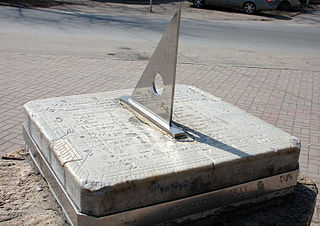 W
WA gnomon is the part of a sundial that casts a shadow. The term is used for a variety of purposes in mathematics and other fields.
 W
WA sundial is a device that indicates time by using a light spot or shadow cast by the position of the Sun on a reference scale. As the Earth turns on its polar axis, the sun appears to cross the sky from east to west, rising at sun-rise from beneath the horizon to a zenith at mid-day and falling again behind the horizon at sunset. Both the azimuth (direction) and the altitude (height) can be used to create time measuring devices. Sundials have been invented independently in every major culture and became more accurate and sophisticated as the culture developed.
 W
WKinnordy House is an estate house near Kirriemuir in Angus, Scotland. The first house was built in the 1680s, when Inverquharity Castle was vacated; however, the current three-storey, towered and turreted structure dates from 1881, incorporating an 18th-century wing and stables. The house was the birthplace of the noted geologist Charles Lyell, and is associated with his friend Charles Darwin.
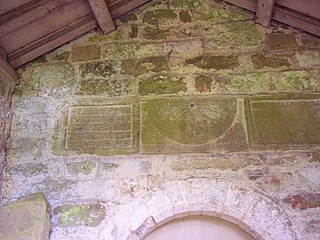 W
WThe Saxon sundial at St Gregory's Minster, Kirkdale in North Yorkshire, near Kirkbymoorside, is an ancient canonical sundial which dates to the mid 11th century.
 W
WMany sundials bear a motto to reflect the sentiments of its maker or owner.
 W
WA London dial in the broadest sense can mean any sundial that is set for 51°30′ N, but more specifically refers to a engraved brass horizontal sundial with a distinctive design. London dials were originally engraved by scientific instrument makers. The trade was heavily protected by the system of craft guilds.
 W
WMan Enters the Cosmos is a cast bronze sculpture by Henry Moore located on the Lake Michigan lakefront outside the Adler Planetarium in the Museum Campus area of downtown Chicago, Illinois.
 W
WThe MarsDial is a sundial that was devised for missions to Mars. It is used to calibrate the Pancam cameras of the Mars landers. MarsDials were placed on the Spirit and Opportunity Mars rovers, inscribed with the words "Two worlds, One sun" and the word "Mars" in 22 languages. The MarsDial can function as a type of sun-dial known as a gnomon, in modern times this is the stick part of a sundial. A gnomon type sundial is basically a "stick in the ground" design, but by looking at the length and direction of the shadow the time of day can be calculated. The sundial can also be used to tell which way is North, and to overcome the limitations of a magnetic north different from a true north.
 W
WMoondials are time pieces similar to a sundial. The most basic moondial, which is identical to a sundial, is only accurate on the night of the full moon. Every night after it becomes an additional 48 minutes slow, while every night preceding the full moon it is 49 minutes fast, assuming there is even enough light to take a reading by. Thus, one week to either side of the full moon the moondial will read 5 hours and 36 minutes before or after the proper time.
 W
WThe National University of Natural Medicine (NUNM) is a private university of naturopathic medicine and Classical Chinese medicine located in Portland, Oregon. The school has approximately 553 students.
 W
WA navicula de Venetiis or "little ship of Venice" was an altitude dial used to tell time and which was shaped like a little ship. The cursor was slid up/down the mast to the correct latitude. The user then sighted the sun through the pair of sighting holes at either end of the "ship's deck". The plumb line then marked what hour of the day it was. Some naviculas had additional information inscribed, such as the latitude of some common English towns, some zodiac signs, etc.
 W
WThe Noon mark is a type of sundial that at its simplest is a vertical line on a south facing wall or a north-south line on a horizontal pavement. When the shadow of a point crosses the line it will be midday. Noon in local standard time is defined as when the sun is overhead, however clocks and watches use mean time which varies from standard time by a few minutes each day. The difference is calculated using the equation of time and this can be shown on the noon mark by drawing an analemma, or using a correction table.
 W
WA statue of Olav Tryggvason is located in Trondheim, Norway. Sculpted by sculptor Wilhelm Rasmussen, it honors King Olav Tryggvason who was the city's founder.
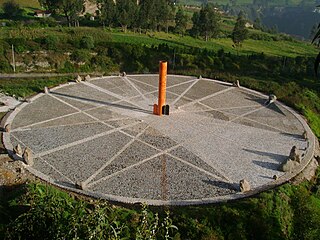 W
WThe Quitsato Sundial is a cultural-tourist place located at La Mitad Del Mundo, near to Cayambe, 47 km north of Quito, Ecuador. It was built in 2006 and inaugurated in 2007 as an independent, non-profit project in a 24,756 ft² area. Its main goal is to share crucial aspects of the astronomical knowledge of the prehispanic cultures of the region. The expositions are carried out by community members as a self-sustaining project.
 W
WVertical declining dials are sundials that indicate local apparent time. Vertical south dials are a special case: as are vertical north, vertical east and vertical west dials. The word declining means that the wall is offset from one of these 4 cardinal points. There are dials that are not vertical, and these are called reclining dials.
 W
WA shepherd's dial is a type of sundial that measures the height of the sun via the so-called umbra versa. Its design needs to incorporate a fixed latitude, but it is small and portable. It is named after Pyrenean shepherds, who would trace such a sundial on their staffs. This type of sundial was very popular in the 16th, 17th and 18th centuries.
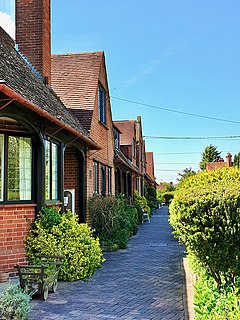 W
WSidney Hill Cottage Homes, whose official name is Sidney Hill Churchill Wesleyan Cottage Homes, is a Grade II listed estate of Wesleyan cottage homes in the village of Churchill in North Somerset. It was opened in December 1907 to provide furnished accommodation for people in need. Designed in an Arts and Crafts Vernacular style by Thomas Ball Silcock and Samuel Sebastian Reay of Silcock and Reay, architects at Bath and London, twelve cottages were constructed on three sides of a quadrangle, with landscaped gardens. The third, or south side, is enclosed by a low terrace wall with wrought iron gates. A large stone sundial, with a spreading base, is set in the centre of the quadrangle. In their original form, each house had a living room, with a small scullery, larder, coal house, and one bedroom with a large storeroom.
 W
WThe Societat Catalana de Gnomónica is, among other cultural groups, a non-profit association that promotes all aspects of sundials.
 W
WThe Solarium Augusti was an ancient Roman monument in the Campus Martius constructed during the reign of Augustus. It functioned as a giant solar marker, according to various interpretations serving either as a simple meridian line or as a sundial. The obelisk belonged to Egyptian Pharaoh Psamtik II.
 W
WThe Sundial Bridge is a cantilever spar cable-stayed bridge for bicycles and pedestrians that spans the Sacramento River in Redding, California, United States and forms a large sundial. It was designed by Santiago Calatrava and completed in 2004 at a cost of US$23.5 million. The bridge has become iconic for Redding.
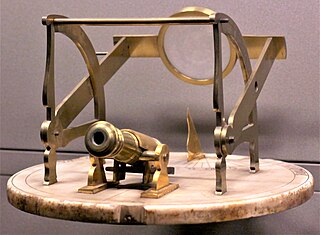 W
WA sundial cannon, sundial gun, noon cannon or meridian cannon, also noonday gun is a device consisting of a sundial incorporating a cannon with a fuse that is lit by an overhanging lens, concentrating the rays of the sun, and causing the cannon to fire at noon, when properly oriented along a north–south axis. The cannon sizes ranged from large to small depending on the location of their use. The household variety was used in estates to signal the time for the midday meal. Larger sizes were used in European parks to signal noon.
 W
WThe Sunquest Sundial is a sundial designed by Richard L. Schmoyer in the 1950s. Adjustable for latitude and longitude, the Sunquest's gnomon automatically corrects for the equation of time allowing it to tell clock time.
 W
WThe Millennium Dial Armillary is one of six pieces of public art located in the town centre of Sutton in Greater London, England. The others include the Sutton heritage mosaic, the Sutton twin towns mural and the Messenger statue.
 W
WTagg's Island, in the London Borough of Richmond upon Thames, is an island on the River Thames on the reach above Molesey Lock and just above Ash Island.
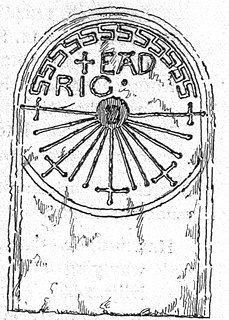 W
WA tide dial, also known as a Mass or scratch dial, is a sundial marked with the canonical hours rather than or in addition to the standard hours of daylight. Such sundials were particularly common between the 7th and 14th centuries in Europe, at which point they began to be replaced by mechanical clocks. There are more than 3,000 surviving tide dials in England and at least 1,500 in France.
 W
WThe Whitehurst & Son sundial was produced in Derby in 1812 by the nephew of John Whitehurst. It is a fine example of a precision sundial telling local apparent time with a scale to convert this to local mean time, and is accurate to the nearest minute. The sundial is now housed in the Derby Museum and Art Gallery.
 W
WGiovanni Francesco Zarbula was a mural painter and sundial designer from Piedmont Italy who created a hundred or more vertical and vertical declining sundials in the French and Italian Alpes between 1830 and 1881. He worked exclusively in Savoy, in Piémont, the Valley of the Ubaye, le Queyras and around Briançon.
 W
WZoharei Chama Synagogue, also spelled Zohorei Chama, colloquially known as the Sundial Building or Mahane Yehuda Clock Tower, is a three-story stone building with a wooden attic on Jaffa Road in Jerusalem, Israel, which features a huge, 5-metre (16 ft) diameter sundial on its façade. The building, constructed in stages by Rabbi Shmuel Levy from 1908 to 1917, was built to house a hostel for immigrants and a synagogue. It was damaged by fire in 1941 and partly restored by the Jerusalem municipality in 1980. Today it still houses the Zoharei Chama Orthodox synagogue, which has prayer services throughout the day for local businessmen, residents and tourists.